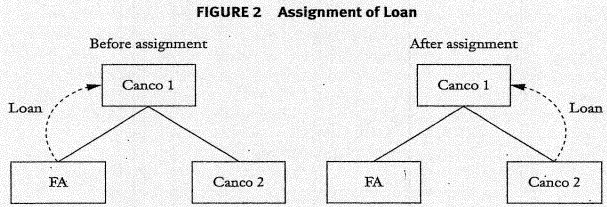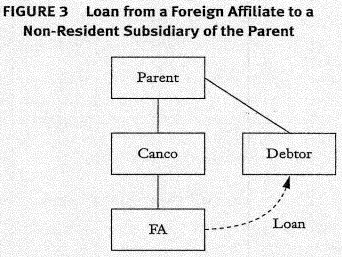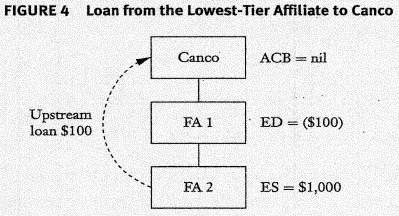Narrowness of repayment rule (p. 251)
There are situations in which an upstream loan may cease to represent a synthetic distribution from a foreign affiliate without the loan being repaid. However, because there is no repayment, the, appropriate relief is not available…
Non-exclusion where FA is sold to Canco's NR parent (p.252)
[I]n Figure 1…[a] non-resident corporation (Parent) owns all of the shares of a Canadian-resident corporation (Canco). Canco in turn owns all of the shares of another non-resident corporation (Subco). Subco makes a loan to Parent, which is not repaid within two years. At the time of the loan, Subco is a foreign affiliate of Canco, and Parent is a specified debtor in respect of Canco. Subsection 90(6) will therefore apply to Canco in respect of the loan.
Canco subsequently sells the shares of Subco to Parent for fair market value consideration. In this example, since Subco ceases to be a foreign affiliate of Canco, the loan should no longer represent a synthetic distribution of funds from a foreign affiliate….[T]he loan proceeds have been effectively repatriated to Canco, with full tax consequences for Canco….However, because the loan has not been repaid, no deduction is available under subsection 90(14).
Whether repayment and new loan following FA's sale to NR parent is a series (p. 255)
In some situations, it may not be possible to repay the upstream loan until after the creditor affiliate has ceased to be a foreign affiliate of the taxpayer….In a variation of the example in figure 1, if Parent repaid the existing loan after Subco ceased to be a foreign affiliate, and Subco made a new loan shortly thereafter, would the repayment of the existing loan be a part of a series?...Since loans by non-residents that are not foreign affiliates are outside the intended scope of the upstream loan rules, the new 1oan made by Subco should not be relevant when applying the series test in this context.
Non-exclusion following loan assignment by FA to Canco 2 (pp. 255-6)

Consider figure 2, in which a Canadian-resident company (Canco 1) has received a loan from a foreign affiliate (FA). This loan is subject to the upstream loan rules, although the subsection 90(6) income inclusion is partially offset by an annual subsection 90(9) deduction (by virtue of the surplus balances of FA). FA then assigns the loan to Canco 2, another Canadian-resident corporation, which is related to Canco 1, for fair market value consideration (without any novation of the loan). [fn 28: The CRA has stated that an assignment of a debt receivable to a new creditor without novation of the debt would not be considered a repayment of the debt for the purposes of subsection 15(2.6): see CRA document no. 2013-0482991E5, September 8, 2014.] The loan should now fall outside the intended scope of the upstream loan rules, since it is a loan between two Canadian corporations…However, since the loan is not repaid, it appears that from a technical perspective no deduction is available under subsection 90(14).
Non-exclusion where Canco acquires the NR affiliated debtor (pp. 256-7)
The next two scenarios involve a Canadian-resident corporation (Canco) that is a wholly owned subsidiary of a non-resident corporation (Parent). A foreign affiliate of Canco (FA) has made a loan to a non-resident subsidiary of Parent (Debtor) (see figure 3). Since Debtor does not deal at arm's length with Canco and is not a controlled foreign affiliate of Canco within the meaning of section 17, the upstream loan rules will apply to this loan.
In the first scenario, Canco acquires all of the shares of Debtor, so that Debtor becomes a controlled foreign affiliate of Canco. Since the loan is now between two controlled foreign affiliates of Canco, it should no longer represent a synthetic distribution from a foreign affiliate….
Non-exclusion where arm's length purchase of NR affiliated debtor (pp. 256-7)
In the second scenario, the shares of Debtor are sold to an unrelated third party, so that Debtor now deals at arm's length with Canco. In this scenario, it is less clear whether the loan continues to fall within the intended scope of the upstream loan rules….v
Narrowness of s. 90(11) (p. 261)
Subsection 90(11) incorporates only the surplus of the downstream foreign affiliates that are directly or indirectly owned by the creditor affiliate. Where the lowest-tier foreign affiliate makes an upstream loan, subsection 90(11) does not apply, and the taxpayer must apply the notional distribution analysis in subsection 90(9) based on the surplus balances of each relevant foreign affiliate in the chain to determine whether, and to what extent., there is a Canadian tax benefit associated with the upstream loan….
Blocking deficit in top-tier FA (pp. 261-3)
[i]n figure 4. A Canadian-resident corporation (Canco) owns all of the shares of a non-resident corporation (FA 1). Canco's ACB in respect of the FA 1 shares is nil. FA 1 has an exempt deficit of $100 in respect of Canco and owns all of the shares of a non-resident corporation (FA 2), which has $1,000 of exempt surplus in respect of Canco. FA 2 makes a $100 loan to Canco, which is not repaid within two years.
If, rather than making an upstream loan, FA 2 paid a dividend of $100, FA 1's exempt deficit would be reduced to nil (computed as the initial exempt deficit of $100 less the $100 exempt surplus dividend from FA 2). If FA 1 then paid a dividendof $100 to Canco, Canco would have an income inclusion equal to $100 pursuant to subsection 90(1) and could claim an offsetting deduction of $100 pursuant to paragraph 113(l)(d) for the portion of the dividend deemed paid out of FA 1's pre-acquisition surplus. There would also be a $100 reduction in the ACB of the FA 1 shares held by Canco. In this case, the ACB of the shares would become negative, and Canco would be deemed to have realized a $100 capital gain from a disposition of the FA 1 shares pursuant to subsection 40(3). However, Canco could then file an election pursuant to subsection 93(1) in the amount of $100 to reduce the subsection 49(3) gain to nil….
[A]t the time that FA 2 makes its upstream loan of $100, FA 1 has a deficit oF$100 and the FA 1 shares have no ACB to Canco. After the notional distribution of FA 2's surplus to FA 1, FA 1's net surplus is still less than the amount of the upstream loan; therefore, the taxpayer must rely on clause 90(9)(a)(i)(D) to claim a full subsection 90(9) deduction. [fn 37: This clause refers to the deduction that would be available under paragraph 113(l)(d) for the portion of the notional distribution paid from preacquisition surplus. Subsection 90(11) does not apply since FA 2 made the loan, rather tiian FA 1. If, instead, FA 2 paid a dividend to FA 1 and FA 1 then made the loan to Canco, subsection 90(11) would apply, resulting in an available reserve of $100.] However, in contrast to the case of an actual dividend payment, the amount of the notional paragraph 113(l)(d) deduction under clause 90(9)(a)(i)(D) is limited to the amount of the ACB of the FA 1 shares to Canco at the time. In thi.q case, there is no ACB and therefore no ability to claim a subsection 90(9) deduction in respect of the upstream loan from FA 2.
This example illustrates that, no matter the quantum of surplus pools in a foreign affiliate group, a "blocking deficit" in a top-tier foreign affiliate may result in an income inclusion under the upstream loan rules, even in situations where a series of dividends could have h&ea-pa&d-iree of Canadian tax….
Multiple application of same blocking deficit (p. 263)
…FA 2 makes three $100 loans to Canco, one on each of day 1, day 2, and day 3, and none of these I loans is repaid within two years. This example (illustrated in figure 5) demonstrates What the problem with blocking deficits described above can be multiplied when applying the reserve mechanism….
[W]hen calculating the amount of any reserve available pursuant to subsection 90(9), each upstream loan must be analyzed as a separate notional distribution at the time that FA 2 advanced the loan. It does not appear to be possible, when applying paragraph 90(9)(a) to a new upstream loan amount, to consider the movement of surplus on prior notional distributions. In the situation depicted in figure 5, this means that FA 1 will continue to have a $100 deficit for the purposes of each notional distribution made by FA2. As a result, Canco will not be able to claim any subsection 90(9) deduction….



